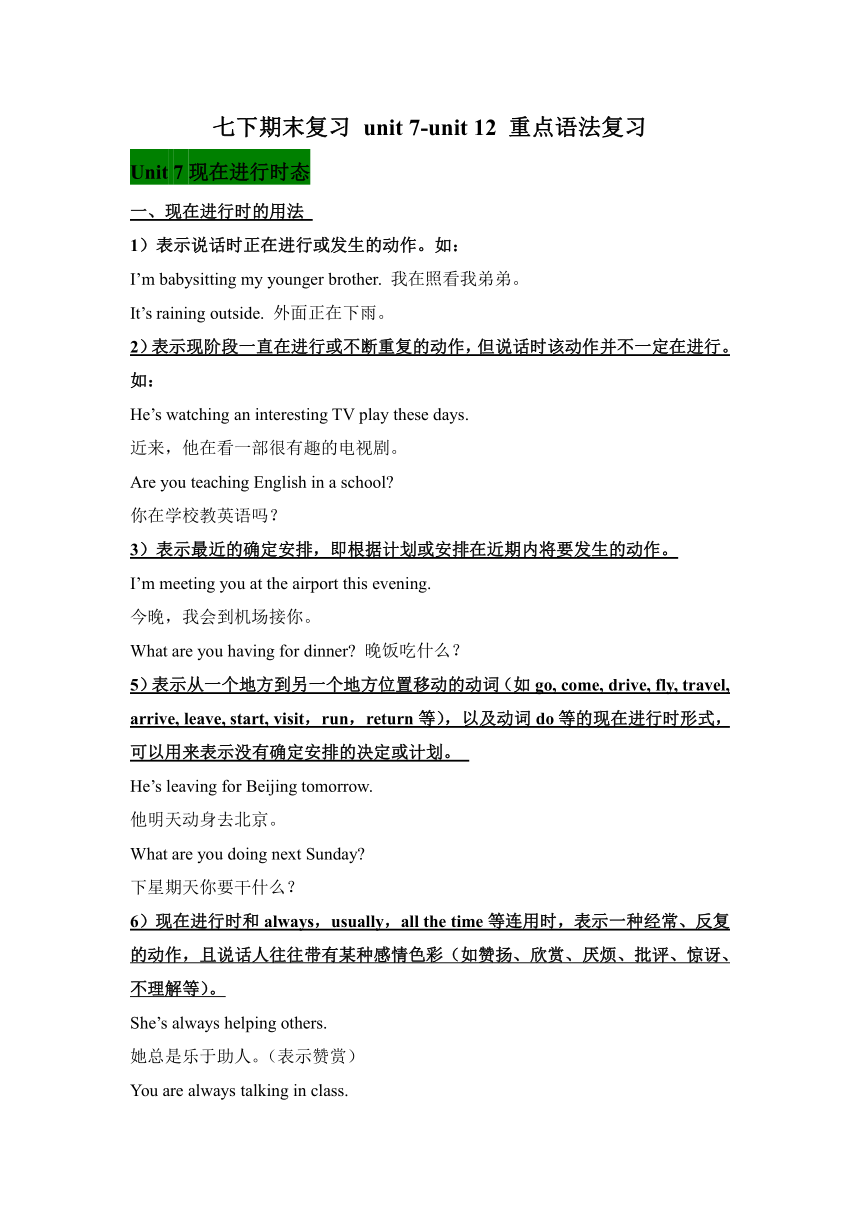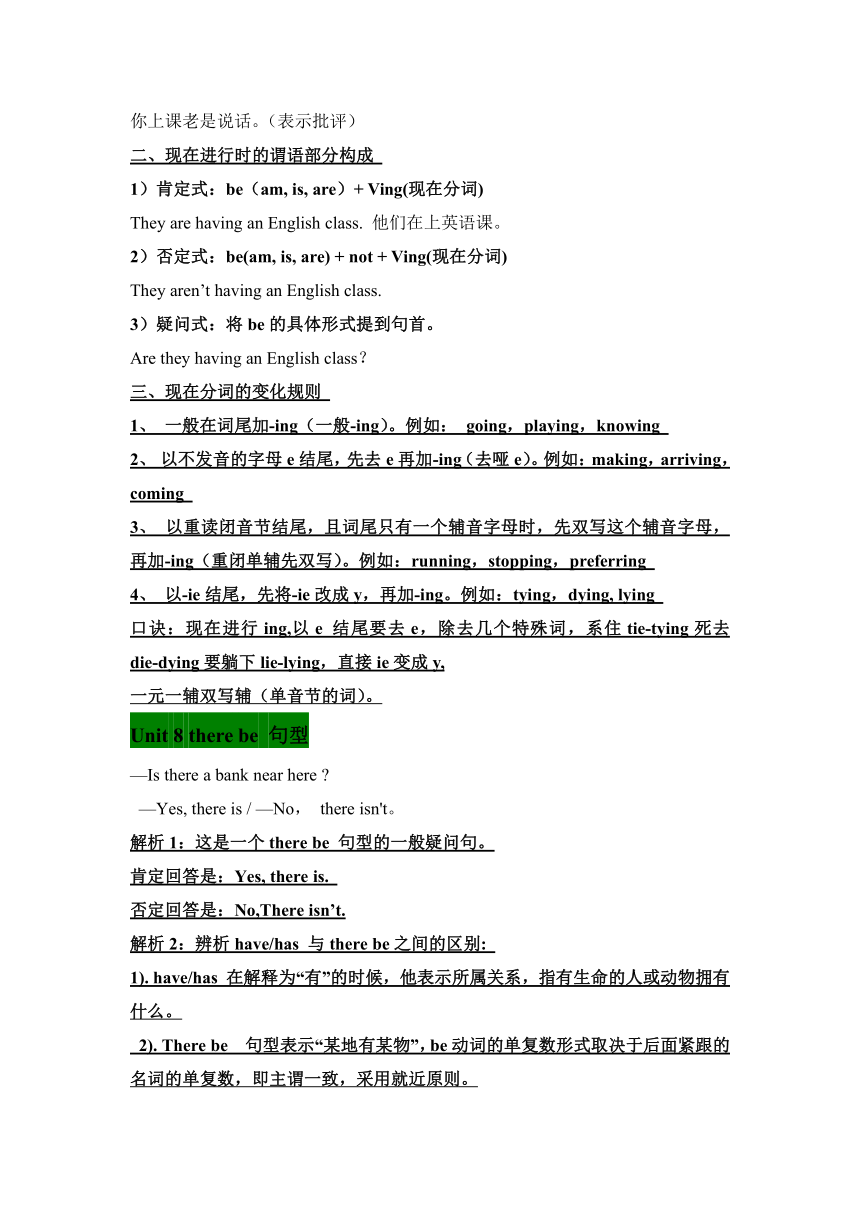人教版七年级下册 Unit 7-unit 12 期末重点语法复习学案
文档属性
| 名称 | 人教版七年级下册 Unit 7-unit 12 期末重点语法复习学案 |  | |
| 格式 | docx | ||
| 文件大小 | 18.8KB | ||
| 资源类型 | 教案 | ||
| 版本资源 | 人教新目标(Go for it)版 | ||
| 科目 | 英语 | ||
| 更新时间 | 2024-06-20 12:28:00 | ||
图片预览



文档简介
七下期末复习 unit 7-unit 12 重点语法复习
Unit 7现在进行时态
一、现在进行时的用法
1)表示说话时正在进行或发生的动作。如:
I’m babysitting my younger brother. 我在照看我弟弟。
It’s raining outside. 外面正在下雨。
2)表示现阶段一直在进行或不断重复的动作,但说话时该动作并不一定在进行。如:
He’s watching an interesting TV play these days.
近来,他在看一部很有趣的电视剧。
Are you teaching English in a school
你在学校教英语吗?
3)表示最近的确定安排,即根据计划或安排在近期内将要发生的动作。
I’m meeting you at the airport this evening.
今晚,我会到机场接你。
What are you having for dinner 晚饭吃什么?
5)表示从一个地方到另一个地方位置移动的动词(如go, come, drive, fly, travel, arrive, leave, start, visit,run,return等),以及动词do等的现在进行时形式,可以用来表示没有确定安排的决定或计划。
He’s leaving for Beijing tomorrow.
他明天动身去北京。
What are you doing next Sunday
下星期天你要干什么?
6)现在进行时和always,usually,all the time等连用时,表示一种经常、反复的动作,且说话人往往带有某种感彩(如赞扬、欣赏、厌烦、批评、惊讶、不理解等)。
She’s always helping others.
她总是乐于助人。(表示赞赏)
You are always talking in class.
你上课老是说话。(表示批评)
二、现在进行时的谓语部分构成
1)肯定式:be(am, is, are)+ Ving(现在分词)
They are having an English class. 他们在上英语课。
2)否定式:be(am, is, are) + not + Ving(现在分词)
They aren’t having an English class.
3)疑问式:将be的具体形式提到句首。
Are they having an English class?
三、现在分词的变化规则
1、 一般在词尾加-ing(一般-ing)。例如: going,playing,knowing
2、 以不发音的字母e结尾,先去e再加-ing(去哑e)。例如:making,arriving,coming
3、 以重读闭音节结尾,且词尾只有一个辅音字母时,先双写这个辅音字母,再加-ing(重闭单辅先双写)。例如:running,stopping,preferring
4、 以-ie结尾,先将-ie改成y,再加-ing。例如:tying,dying, lying
口诀:现在进行ing,以e 结尾要去e,除去几个特殊词,系住tie-tying死去die-dying要躺下lie-lying,直接ie变成y,
一元一辅双写辅(单音节的词)。
Unit 8 there be 句型
—Is there a bank near here
—Yes, there is / —No, there isn't。
解析1:这是一个there be 句型的一般疑问句。
肯定回答是:Yes, there is.
否定回答是:No,There isn’t.
解析2:辨析have/has 与there be之间的区别:
1). have/has 在解释为“有”的时候,他表示所属关系,指有生命的人或动物拥有什么。
2). There be 句型表示“某地有某物”,be动词的单复数形式取决于后面紧跟的名词的单复数,即主谓一致,采用就近原则。
Unit 9询问及描述某人的长相
1)询问长相 句型What+ do/does+ sb.+ look like
eg. What do you look like What does he look like?
2)描述长相
a.身高方面 He/She is tall/short/of medium height.
b.身材方面 He/She is thin/heavy/of medium build.
c.头发方面 He/She has long/short/curly /straight hair.
d.穿衣方面 He usually wears jeans, a T-shirt and sports shoes.
e.五官及其他 He/She has a big/small nose/mouth.
He/She has a long/round face.
He/She has big/small eyes and wears glasses.
描述性形容词
当名词前有多个形容词修饰时,一般遵循的规律为:限定词(冠词、指示代词、物主代词、数词等)+表示观点的描述性形容词+形状、大小、长短、高低+年龄、新旧+颜色+国籍、地区+物质材料+中心词。
that big round apple a tall medical worker
an expensive new Japanese sports car
Unit 10
1. would like“想要”,相当于want, 用法亦同want,但比want委婉。
1)want/would like sth. 想要某物
I’d like some noodles
2)want/would like to do sth. 想要做某事
I’d like to play the piano
3)want/would like sb. to do sth. 想要某人做某事
I would like him to help me.
4)What would sb. like 某人想要什么?
What would they like They would like some noodles.
5)What would sb. like to do 某人想要做什么?
What would they like to have They would like to have some noodles.
6)would you like sth. 你想要某物吗?(委婉地询问对方的要求时的用语)
肯定回答:Yes, please.
否定回答:No, thanks.
Would you like some more food
Yes, please.
No, thanks.
7) Would you like to do sth?你想要/愿意做某事吗?(向对方有礼貌地提出建议或邀请)
肯定回答:Yes, I’d like/love to. 是的,我愿意。
否定回答:Sorry, + 原因。
Would you like to go shopping with us 你想要/愿意和我们一起去购物吗?
Yes, I’d like/love to. 是的,我愿意。
Sorry, I have a lot of homework to do.
不可数名词
不可数名词没有复数形式,分为物质名词(表示无法分为个体的物质,如meat,rice,water,milk,orange,beef,soup,mutton,tea,coffee等)和抽象名词(表示动作、状态、情况、品质等抽象概念,如work,homework,time,health,friendship等)。
不可数名词的数量表示:有许多与食物、饮料有关的名词是不可数名词,他们可以和量词连用,量词有复数形式,three glasses of milk三杯牛奶,some cups of tea几杯茶,a piece of bread一块面包,two bowls of rice两碗米饭;five bottles of juice两瓶果汁;
既可为可数名词又可为不可数名词
chicken 鸡(可数),鸡肉(不可数);orange 橘子(可数),橘子汁(不可数);fish 鱼(可数),鱼肉(不可数);salad 沙拉;ice-cream 冰激淋;cabbage 卷心菜、洋白菜;
Unit 11-Unit 12
般过去式
一、概念
一般过去时用来表示过去某一时间内发生的动作或存在的状态以及过去习惯性、反复性的动作。谓语动词要用动词的过去式,常和表示过去的时间状语连用,如yesterday昨天、last night昨晚、last week上周、last year去年、…ago等
Tom didn't come to class yesterday.
We went to dance last night.
二、结构
1. Be动词的一般过去时 在没有实义动词的句子中使用be动词
am is 的过去式为was; are的过去式为were,was是表示单数,were是表示复数
肯定句式:主语 + be(was , were) + 其它.
否定句式:主语 + be(was , were) + not + 其它.
一般疑问句:Be(was , were) + 主语 + 其它?
I was at home yesterday.
They were not at home yesterday.
Were they at home yesterday
Yes,they were. No,they weren’t.
2. 实义动词的一般过去时态 肯定句要使用动词的过去式,否定句和疑问句要使用助动词did.
肯定句式:主语 + 动词(过去式)+ 其它
否定句式:主语 + didn’t + 动词(原形)+ 其它 (did not = didn’t)
一般疑问句:Did + 主语+ 动词(原形)+ 其它(do , does的过去时均为did)? 注:did和didn’t 是构成一般过去时的助动词,其特点是要在其后跟动词的原形
I worked in a hospital last year.
I didn’t work in a hospital last year.
Did you work in a hospital Yes, I did. /No.I didn’t.
He studied in America last year.
He didn’t study in America last year.
Did he study in America last year
Yes, he did. / No, he didn’t.
三、规则动词的过去式
1.一般情况下,在动词原形后面加-ed:
looked played started visited stayed
以不发音e结尾的动词,在词尾直接加-d:
lived closed liked loved tasted
3.以“辅音字母+ y”结尾的动词,先将 y 改为i ,加 ed:
study→studied try→tried cry→cried
以重读闭音节(即辅音+元音+辅音)或r音节结尾,末尾只有一个辅音字母的动词,要先双写这个辅音字母后,再加 –ed:
stop→stopped plan→planned
四、不规则动词的过去式需特殊记忆
1. is→was am→was are→were do→did have→had
2. go→went meet→met sleep→slept sweep→swept
Unit 7现在进行时态
一、现在进行时的用法
1)表示说话时正在进行或发生的动作。如:
I’m babysitting my younger brother. 我在照看我弟弟。
It’s raining outside. 外面正在下雨。
2)表示现阶段一直在进行或不断重复的动作,但说话时该动作并不一定在进行。如:
He’s watching an interesting TV play these days.
近来,他在看一部很有趣的电视剧。
Are you teaching English in a school
你在学校教英语吗?
3)表示最近的确定安排,即根据计划或安排在近期内将要发生的动作。
I’m meeting you at the airport this evening.
今晚,我会到机场接你。
What are you having for dinner 晚饭吃什么?
5)表示从一个地方到另一个地方位置移动的动词(如go, come, drive, fly, travel, arrive, leave, start, visit,run,return等),以及动词do等的现在进行时形式,可以用来表示没有确定安排的决定或计划。
He’s leaving for Beijing tomorrow.
他明天动身去北京。
What are you doing next Sunday
下星期天你要干什么?
6)现在进行时和always,usually,all the time等连用时,表示一种经常、反复的动作,且说话人往往带有某种感彩(如赞扬、欣赏、厌烦、批评、惊讶、不理解等)。
She’s always helping others.
她总是乐于助人。(表示赞赏)
You are always talking in class.
你上课老是说话。(表示批评)
二、现在进行时的谓语部分构成
1)肯定式:be(am, is, are)+ Ving(现在分词)
They are having an English class. 他们在上英语课。
2)否定式:be(am, is, are) + not + Ving(现在分词)
They aren’t having an English class.
3)疑问式:将be的具体形式提到句首。
Are they having an English class?
三、现在分词的变化规则
1、 一般在词尾加-ing(一般-ing)。例如: going,playing,knowing
2、 以不发音的字母e结尾,先去e再加-ing(去哑e)。例如:making,arriving,coming
3、 以重读闭音节结尾,且词尾只有一个辅音字母时,先双写这个辅音字母,再加-ing(重闭单辅先双写)。例如:running,stopping,preferring
4、 以-ie结尾,先将-ie改成y,再加-ing。例如:tying,dying, lying
口诀:现在进行ing,以e 结尾要去e,除去几个特殊词,系住tie-tying死去die-dying要躺下lie-lying,直接ie变成y,
一元一辅双写辅(单音节的词)。
Unit 8 there be 句型
—Is there a bank near here
—Yes, there is / —No, there isn't。
解析1:这是一个there be 句型的一般疑问句。
肯定回答是:Yes, there is.
否定回答是:No,There isn’t.
解析2:辨析have/has 与there be之间的区别:
1). have/has 在解释为“有”的时候,他表示所属关系,指有生命的人或动物拥有什么。
2). There be 句型表示“某地有某物”,be动词的单复数形式取决于后面紧跟的名词的单复数,即主谓一致,采用就近原则。
Unit 9询问及描述某人的长相
1)询问长相 句型What+ do/does+ sb.+ look like
eg. What do you look like What does he look like?
2)描述长相
a.身高方面 He/She is tall/short/of medium height.
b.身材方面 He/She is thin/heavy/of medium build.
c.头发方面 He/She has long/short/curly /straight hair.
d.穿衣方面 He usually wears jeans, a T-shirt and sports shoes.
e.五官及其他 He/She has a big/small nose/mouth.
He/She has a long/round face.
He/She has big/small eyes and wears glasses.
描述性形容词
当名词前有多个形容词修饰时,一般遵循的规律为:限定词(冠词、指示代词、物主代词、数词等)+表示观点的描述性形容词+形状、大小、长短、高低+年龄、新旧+颜色+国籍、地区+物质材料+中心词。
that big round apple a tall medical worker
an expensive new Japanese sports car
Unit 10
1. would like“想要”,相当于want, 用法亦同want,但比want委婉。
1)want/would like sth. 想要某物
I’d like some noodles
2)want/would like to do sth. 想要做某事
I’d like to play the piano
3)want/would like sb. to do sth. 想要某人做某事
I would like him to help me.
4)What would sb. like 某人想要什么?
What would they like They would like some noodles.
5)What would sb. like to do 某人想要做什么?
What would they like to have They would like to have some noodles.
6)would you like sth. 你想要某物吗?(委婉地询问对方的要求时的用语)
肯定回答:Yes, please.
否定回答:No, thanks.
Would you like some more food
Yes, please.
No, thanks.
7) Would you like to do sth?你想要/愿意做某事吗?(向对方有礼貌地提出建议或邀请)
肯定回答:Yes, I’d like/love to. 是的,我愿意。
否定回答:Sorry, + 原因。
Would you like to go shopping with us 你想要/愿意和我们一起去购物吗?
Yes, I’d like/love to. 是的,我愿意。
Sorry, I have a lot of homework to do.
不可数名词
不可数名词没有复数形式,分为物质名词(表示无法分为个体的物质,如meat,rice,water,milk,orange,beef,soup,mutton,tea,coffee等)和抽象名词(表示动作、状态、情况、品质等抽象概念,如work,homework,time,health,friendship等)。
不可数名词的数量表示:有许多与食物、饮料有关的名词是不可数名词,他们可以和量词连用,量词有复数形式,three glasses of milk三杯牛奶,some cups of tea几杯茶,a piece of bread一块面包,two bowls of rice两碗米饭;five bottles of juice两瓶果汁;
既可为可数名词又可为不可数名词
chicken 鸡(可数),鸡肉(不可数);orange 橘子(可数),橘子汁(不可数);fish 鱼(可数),鱼肉(不可数);salad 沙拉;ice-cream 冰激淋;cabbage 卷心菜、洋白菜;
Unit 11-Unit 12
般过去式
一、概念
一般过去时用来表示过去某一时间内发生的动作或存在的状态以及过去习惯性、反复性的动作。谓语动词要用动词的过去式,常和表示过去的时间状语连用,如yesterday昨天、last night昨晚、last week上周、last year去年、…ago等
Tom didn't come to class yesterday.
We went to dance last night.
二、结构
1. Be动词的一般过去时 在没有实义动词的句子中使用be动词
am is 的过去式为was; are的过去式为were,was是表示单数,were是表示复数
肯定句式:主语 + be(was , were) + 其它.
否定句式:主语 + be(was , were) + not + 其它.
一般疑问句:Be(was , were) + 主语 + 其它?
I was at home yesterday.
They were not at home yesterday.
Were they at home yesterday
Yes,they were. No,they weren’t.
2. 实义动词的一般过去时态 肯定句要使用动词的过去式,否定句和疑问句要使用助动词did.
肯定句式:主语 + 动词(过去式)+ 其它
否定句式:主语 + didn’t + 动词(原形)+ 其它 (did not = didn’t)
一般疑问句:Did + 主语+ 动词(原形)+ 其它(do , does的过去时均为did)? 注:did和didn’t 是构成一般过去时的助动词,其特点是要在其后跟动词的原形
I worked in a hospital last year.
I didn’t work in a hospital last year.
Did you work in a hospital Yes, I did. /No.I didn’t.
He studied in America last year.
He didn’t study in America last year.
Did he study in America last year
Yes, he did. / No, he didn’t.
三、规则动词的过去式
1.一般情况下,在动词原形后面加-ed:
looked played started visited stayed
以不发音e结尾的动词,在词尾直接加-d:
lived closed liked loved tasted
3.以“辅音字母+ y”结尾的动词,先将 y 改为i ,加 ed:
study→studied try→tried cry→cried
以重读闭音节(即辅音+元音+辅音)或r音节结尾,末尾只有一个辅音字母的动词,要先双写这个辅音字母后,再加 –ed:
stop→stopped plan→planned
四、不规则动词的过去式需特殊记忆
1. is→was am→was are→were do→did have→had
2. go→went meet→met sleep→slept sweep→swept
同课章节目录
